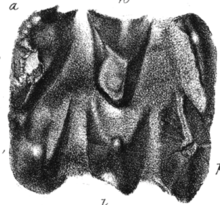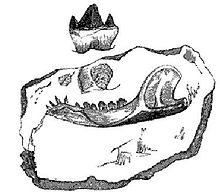
Megalosaurus is an extinct genus of large carnivorous theropod dinosaurs of the Middle Jurassic Epoch of southern England. Although fossils from other areas have been assigned to the genus, the only certain remains of Megalosaurus come from Oxfordshire and date to the late Middle Jurassic.
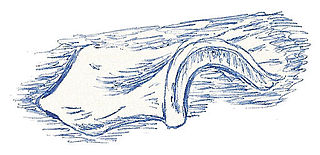
Iliosuchus is a genus of theropod dinosaur known from Bathonian–age rocks of England. It was perhaps 2 metres (6.6 ft) long.

Proceratosaurus is a genus of carnivorous theropod dinosaur from the Middle Jurassic (Bathonian) of England. It contains a single species. P. bradleyi, known from a mostly complete skull and lower jaws. Proceratosaurus was a small dinosaur, estimated to measure around 3 m (9.8 ft) in length. Its name refers to how it was originally thought to be an ancestor of Ceratosaurus, due to the partially preserved portion of the crest of Proceratosaurus superficially resembling the small crest of Ceratosaurus. Now, however, it is considered a coelurosaur, specifically a member of the family Proceratosauridae, and amongst the earliest known members of the clade Tyrannosauroidea.

Megalosauridae is a monophyletic family of carnivorous theropod dinosaurs within the group Megalosauroidea. Appearing in the Middle Jurassic, megalosaurids were among the first major radiation of large theropod dinosaurs. They were a relatively primitive group of basal tetanurans containing two main subfamilies, Megalosaurinae and Afrovenatorinae, along with the basal genus Eustreptospondylus, an unresolved taxon which differs from both subfamilies.
Paleontology or palaeontology is the study of prehistoric life forms on Earth through the examination of plant and animal fossils. This includes the study of body fossils, tracks (ichnites), burrows, cast-off parts, fossilised feces (coprolites), palynomorphs and chemical residues. Because humans have encountered fossils for millennia, paleontology has a long history both before and after becoming formalized as a science. This article records significant discoveries and events related to paleontology that occurred or were published in the year 1824.

Duriavenator is a genus of theropod dinosaur that lived in what is now England during the Middle Jurassic, about 168 million years ago. In 1882, upper and lower jaw bones of a dinosaur were collected near Sherborne in Dorset, and Richard Owen considered the fossils to belong to the species Megalosaurus bucklandii, the first named non-bird dinosaur. By 1964, the specimen was recognised as belonging to a different species, and in 1974 it was described as a new species of Megalosaurus, M. hesperis; the specific name means 'the West' or 'western'. Later researchers questioned whether the species belonged to Megalosaurus, in which many fragmentary theropods from around the world had historically been placed. After examining the taxonomic issues surrounding Megalosaurus, Roger B. J. Benson moved M. hesperis to its own genus in 2008, Duriavenator; this name means "Dorset hunter".
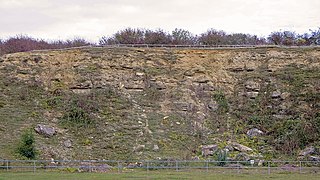
The Forest Marble is a geological formation in England. Part of the Great Oolite Group, it dates to the late Bathonian stage of the Middle Jurassic.
The Balabansai Formation is a geological formation in Kazakhstan, Kyrgyzstan and Uzbekistan whose strata date back to the Bathonian and Callovian stages of the Middle Jurassic. Dinosaur remains are among the fossils that have been recovered from the formation. The lithology primarily consists of variegated sandstones, siltstones, claystones, and rare gravels and marls. Many taxa have been found in the formation, including amphibians and mammals

The Sharp's Hill Formation is a Bathonian geologic formation in North Oxfordshire north-east of Milton-under-Wychwood and Minster Lovell in the United Kingdom, dating to around 167 million years ago. Dinosaur remains diagnostic to the genus level are among the fossils that have been recovered from the formation. It is the lateral equivalent of the Rutland Formation and the Fuller's Earth Formation.

The White Limestone Formation is a Bathonian geologic formation in the United Kingdom, dating to the Middle Jurassic, 168.3 to 166.1 million years ago. Fossil sauropod tracks have been reported from the formation. It is the lateral equivalent of the Blisworth Limestone. It predominantly consists of grey-yellow limestone, typically wackestone and packstone with subordinate ooidal grainstone. The Woodeaton Quarry locality has yielded microvertebrates.
Orectoloboides is an extinct genus of wobbegong sharks. It was described by Cappetta in 1977. A new species, O. angulatus, was described from the Cenomanian age of Canada by Charlie J. Underwood and Stephen L. Cumbaa in 2010.
The Rutland Formation is a geologic formation in England. It preserves fossils dating back to the late Bajocian to Bathonian stages in the Jurassic period, about 169 million years ago. It is the lateral equivalent of the Sharp's Hill Formation and the Fuller's Earth Formation. The "Rutland Dinosaur" specimen of Cetiosaurus is known from the formation.
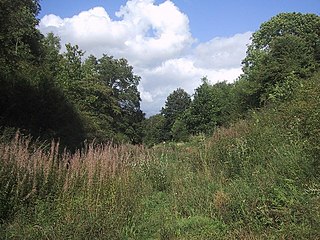
The Chipping Norton Limestone is a geological formation in the Cotswolds, England. It preserves fossils dating back to the Bathonian. Including those of dinosaurs Cetiosaurus, Megalosaurus and Cruxicheiros as well as the Tritylodontid Stereognathus. It primarily consists of ooidal limestone.

Amphitherium is an extinct genus of stem cladotherian mammal that lived during the Middle Jurassic of England. It was one of the first Mesozoic mammals ever described. A recent phylogenetic study found it to be the sister taxon of Palaeoxonodon. It is found in the Forest Marble Formation and the Taynton Limestone Formation.

Mesochelydia is a clade within Pantestudines, more inclusive than Perichelydia, but less than Testudinata. The clade is known from the Early Jurassic to the Present, and contains all Jurassic representatives of Testudinata aside from Australochelys. The ancestral condition for Mesochelydia is thought to be aquatic, as opposed to terrestrial for Testudinata. They are distinguished from more basal testudinatans by the presence of the following characters: strap like pectoral girdle, supramarginals absent, reduced posterior entoplastral process, eleven pairs of peripherals, elongate processus interfenestralis, paired basioccipital tubercles, fully formed cavum tympani and antrum postoticum, single vomer, confluent external nares, lacrimals and supratemporals absent.

Woodeaton Quarry is a 7.3-hectare (18-acre) geological Site of Special Scientific Interest north of Oxford in Oxfordshire. It is a Geological Conservation Review site.
Taeniopteris is an extinct form genus of Mesozoic vascular plant leaves, perhaps representing those of cycads, bennettitaleans, or marattialean ferns. The form genus is almost certainly a polyphyletic category for unfertile leaves of a certain shape ("taeniopterids") which cannot be assigned to specific groups due to a lack of information on cuticle or spore structures. The leaves are simple, with a strong central vein (rhachis) and an unbroken margin. The central vein leads to nearly perpendicular lateral veins, which may be slightly divided or undivided. The shape of the leaf is variable, but often elongated and smooth-edged. "Taeniopterid" leaves with bennettitalean-type cuticle are placed in the form genus Nilssoniopteris, while those with cycad-type cuticle are placed within Nilssonia and related genera. Some fertile "taeniopterids" preserve spore packages, and can be assigned to marattialean ferns.

Egertonodus is an extinct genus of shark-like hybodont fish. It includes E. basanus from the Jurassic of Europe and North Africa and Cretaceous of North America, North Africa and Europe, and E. duffini from the Middle Jurassic of England. Indeterminate remains of the genus have been reported from the Early Cretaceous of Asia. E. basanus is known from preserved skull material, while E. duffini is only known from teeth. The genus is distinguished from Hybodussensu stricto by characters of the skull and teeth. E. basanus, the most common species, is thought to have reached 1.5 m in length. E. fraasi from the Late Jurassic of Germany, known from a poorly preserved full body fossil, was placed in Egertonodus in one study, but this has been subsequently questioned by other authors, due to strong differences in tooth morphology from the type species. Fossils have been found in freshwater and lagoonal environments.

Komlopteris is an extinct genus of "seed fern" with possible corystosperm affinities. Fossils have been found across both hemispheres, dating from the latest Triassic to the early Eocene (Ypresian), making it the youngest "seed fern" in the fossil record.

Planohybodus is an extinct genus of hybodont, known from the Middle Jurassic-Early Cretaceous (Bathonian-Barremian) of Europe and the Indian subcontinent. Fossils have been found in marine as well as freshwater environments. The genus contains 3 confirmed species, two of which were originally assigned to the genus Hybodus. Possible records have been reported from the Late Jurassic of Mexico, the Early Cretaceous of Brazil and the Late Cretaceous (Santonian) of North America, but these are unconfirmed. Planohybodus peterboroughensis is suggested to have reached lengths of 2–3 metres (6.6–9.8 ft). A specimen of the ammonite genus Orthaspidoceras from the Late Jurassic of France has been found with an embedded tooth of Planohybodus, suggesting that while the teeth of Planohybodus were adapted to tearing soft bodied prey, it would attack hard-shelled prey at least on occasion.



